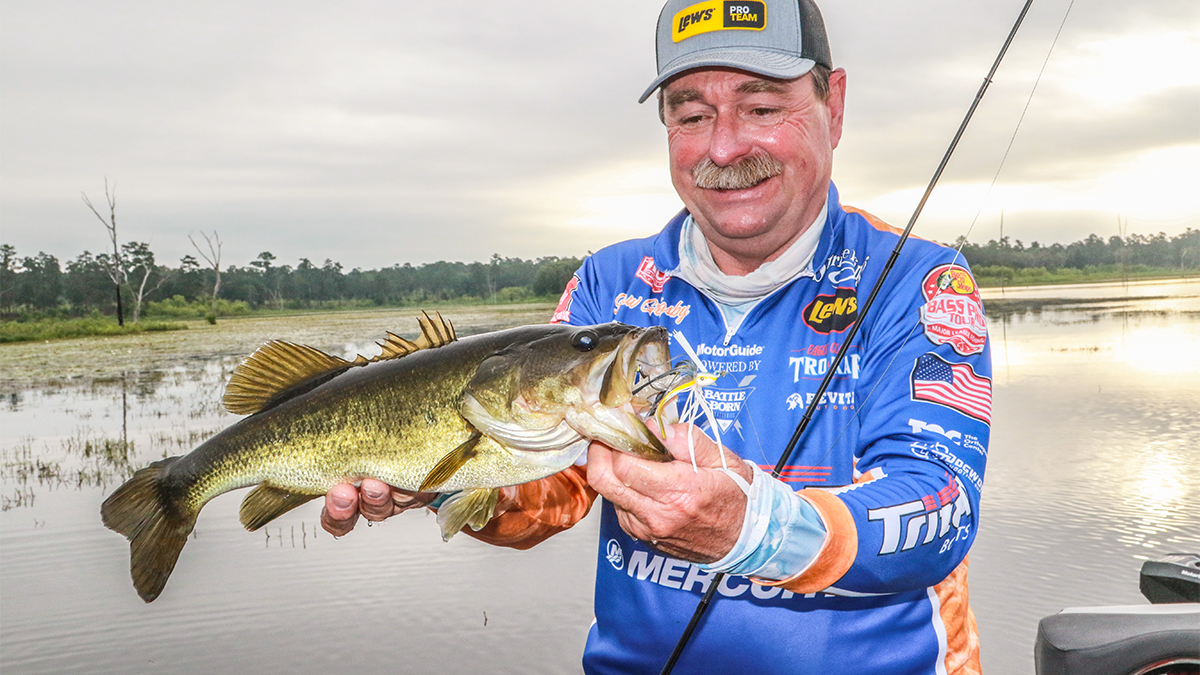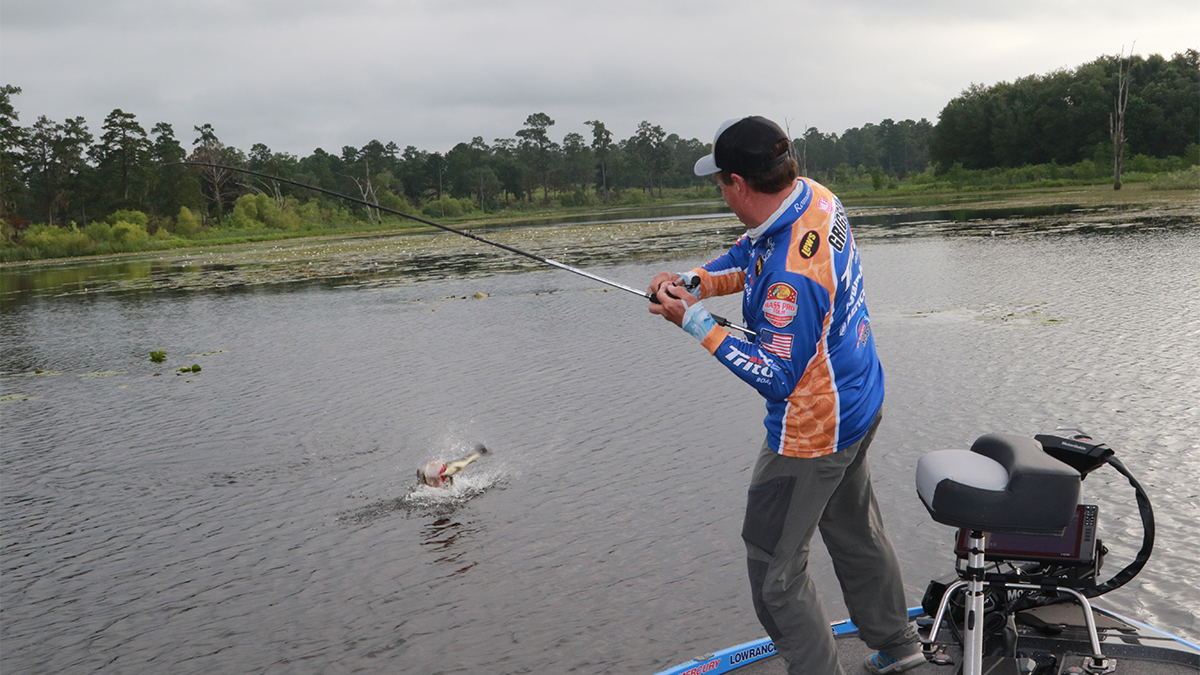You’ll always find a jug of unsweetened ice tea on Shaw Grigsby’s boat and as long as he’s fishing shallow water, the next most consistent inclusion — a bass fishing swim jig. Simply put, it’s his go-to “find-em” bait.
“It’s just a fabulous technique,” the Florida pro said. “You’ll never open my rod box and not find one or two swim jigs tied on.”
The reason is simple: Grigsby values time efficiency. Swim jigs will enter and exit just about anywhere he can place a cast, while presenting a profile that mimics a wide range of finfish forage.
A true 4-wheel-drive bait, Grigsby said he favors the swim jig design because it allows for a multi-tasking strategy. While slipping through grass and pads comprise most of his presentations, he’s also keen to dead stick the bait next to timber for a slow, vulnerable fall, or pitch the jig directly to a stump, laydown or some other attractive target.
Noting how the swim jig shines in weedy waters like those of his home state, Grigsby said, “A lot of people don’t fish a jig in Florida because of all the vegetation, but the swim jig has the right head design to get through that cover.”
Indeed, this headstrong bass fishing bait seamlessly traversing a variety of emergent cover such as water willow, eel grass, pencil reeds, hay grass and Florida’s Kissimmee grass. Grigsby won’t lob a swim jig into the center of a dense lily pad field, but flaring the weed guard a little allows him to fish it through much of the shallow cover where big fish hide.
The package
Preferring the Strike King Hack Attack Heavy Cover Swim Jig for its stout hook and fullback design, Grigsby knows wherever he slings this bait, it’s coming back out — ideally, within a big set of jaws. On the functional side, a long keeper grips the trailer further back on the body.
Less movement means less wear and tear. Still, Grigsby lauds the swim jig’s user-friendly simplicity.
“There’s not much to re-rig,” he said. “So after you catch one you can get back on them pretty quickly.”
While the heavier presentations dominate, Grigsby occasionally goes to the lighter look of a Strike King Tour Grade Swim Jig. This one’s less likely stand up to the harsher neighborhoods, but when the bite is tough and fish are wary, a little modesty goes a long way.
“This bait has a lighter wire needlepoint hook so you can fish it on 10-pound fluorocarbon,” Grigsby said. “You just don’t need that big hook set to get that hook to penetrate. This is also a good bait to throw on a spinning rod with light braid.”
Color Code: Grigsby gives a white shad-imitating swim jig a lot of work, but he also throws a black and blue pattern and his personal favorite — the No. 234 bluegill color. If he’s fishing a lake when bream are bedding that panfish pattern is hard to beat, unless low light and/or a morning shad spawn makes white a better call.
Backseat: Grigsby pairs his swim jig with a Strike King Rage Menace and rigs it vertically to match a natural finfish tail orientation. For the lighter Tour Grade Swim Jig, Grigsby likes a full size Menace cut down by about 1/2 inch, while a Baby Menace or Rage Bug also work.
Presentation strategies
Grigsby’s swim jig philosophy is a broad one: From timber, to docks, to grass, to isolated pad clumps, any bit of cover is good cover. Amid vast fields of grass or pads, he’ll look for points, cuts and anywhere a hungry fish would likely position to feed.
Retrieve speed is typically determined by water clarity, weather, time of day — the factors impacting visibility. When fish can get a good, long look at passersby, Grigsby’s gonna step on the gas to make ‘em decide. Conversely, when bass need their eyeglasses, slowing down yields more connections.
As for retrieve style, Grigsby’s somewhere between a steady wind and the Alabama Shake. Neither is wrong, he said —- unless that’s all you do.
“Whatever you do, break it up so it looks different,” Grigsby said. “Think about a squarebill deflecting off a stump — it doesn’t do that all the time.”
Tackle and tactics
Basing his line choice on visibility, Grigsby said he’s typically going with 50-pound Seaguar TactX braid in off-colored water, but he’ll use fluorocarbon when visibility runs higher. 17- to 20-pound test is his standard range but when he has several feet of visibility, he may drop down as light as 15.
“In vegetation, the line is not as much of a concern because it’s bumping through that cover and the fish is bursting out to get it, rather than tracking it in open water,” Grigsby said. “I use the Lew’s skipping reel because it has a shallow spool that (minimizes) backlashes
“It only holds 40 yards of line, but most of your casts are that or less, so it doesn’t really affect anything you do. I just like never having to mess with the reel.”
Grigsby said he commonly uses the swim jig in tandem with a Strike King Thunder Cricket (vibrating jig). The latter excels in sparser cover and open water; often tickling the tops of grass beds and occasionally snapping it free from temporary snags to trigger bites.
The swim jig also delivers in those light cover scenarios and offers a strategic benefit. Just as bass get tired of rattling and/or wide wobbling crankbaits, too many bladed jigs peppering their world will find them tuning out the bolder look.
Switch over to the sleek, silent swim jig and the ones will a rumble in their belly, or a chip on their shoulder might be more inclined to open their mouth.















